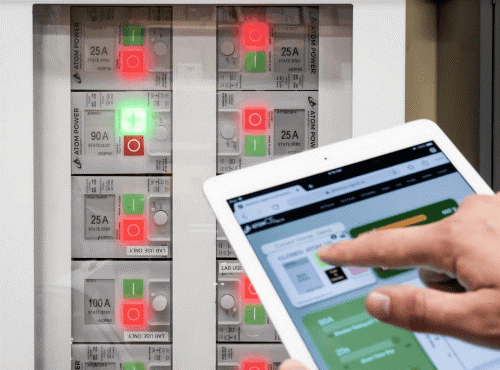By Rick Merritt, Silicon Valley bureau chief, EE Times
Ryan Kennedy is a few months away from shipping products sparked by an arc flash that he saw on a construction site more than 20 years ago. His startup, Atom Power, has a digital circuit breaker now in pilot tests and a second generation based on a custom module coming this summer.
The designs have attracted investments from giants ABB, Eaton, and Siemens, at least one of which is interested in licensing the technology. So the startup must decide soon whether it will be a product or licensing company.
“This year is our inflection point because we’re in discussions with a couple of companies about what licensing looks like,” said Kennedy, the startup’s chief executive. His “aha moment” came in the late 1990s when working as an electrician’s helper on large commercial sites.
“I saw two arc flashes, and I wanted to design products to do something about them, so I went to college and got an engineering degree,” he said. “I got interested in power semiconductors in college, and it hit me that if you could make a viable digital circuit breaker, it would have an enormous impact.”
Years later, he formed his own engineering services company, got a contract in Silicon Valley, and attended a power conference with a colleague who would become his chief technologist. “I told him about my idea for solid-state breakers — he had a Ph.D. in power electronics — so we looked at some data sheets and thought it was feasible.”

The design enables circuit breakers that can be configured and controlled by software. (Image: Atom Power)
Their first step was to prototype a design based on an Arduino board and components from a local Radio Shack. In 2015, they got funding and started attracting interest from giants in the field. “This isn’t a new idea,” he said. “Even some of our investors have tried it but haven’t been successful. A lot of it is materials science.”
Off-the-shelf silicon-carbide components are key to Atom Power’s design. But the startup’s secret sauce is in details of how it configures and assembles them into a module to deliver 99.9% efficiency at full power load and withstand a 600% overload in case of a failure.
The initial designs are two- and three-phase, 480-V units targeting large industrial and commercial users. “That’s where the pain points are,” he said, noting that potential users also include aerospace companies, the military, and utilities.
Atom Power’s first-generation products are now in trials and just got approval from Underwriters Labs. A second generation using its own module design could be approved and ship as early as July for pilot projects, with first commercial shipments expected next year at a current supply-chain capacity of 1,000 panels a month.
“It’s a life-safety device, so there’s a natural tendency to take it slowly,” he said.
Atom’s products are as much as five times the cost of traditional mechanical breakers first invented 140 years ago. But when you add in safety gear such as meters and soft-start devices that mechanical breakers need, the startup’s design is two-thirds of their price.
The company has raised $10 million in funding to date and foresees profits within two years. However, if it decides to scale up into being a product company, it might seek as much as $50 million in additional capital.
This article was originally published on EE Times .
Advertisement
Learn more about Electronic Products Magazine





